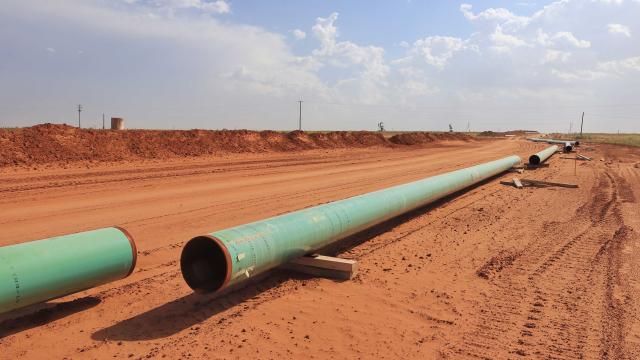
Pipeline construction in the Permian Basin is finally catching up to the play's production. (Source: Shutterstock)
It’s been almost 100 years since the Permian Basin’s first commercial well, Santa Rita No. 1, was brought online about 60 miles outside of Midland, Texas. This began a nearly 50-year run of prosperity for the Midland portion of the Permian. However, the Permian Basin began to experience production declines in the 1970s.
The development of hydraulic fracturing techniques in the early part of this century helped several “past their prime” plays find their fastball again with the Permian joining this rejuvenated group about 10 years ago.
In the past decade, production growth has been so strong that the midstream has had trouble keeping pace with transportation capacity out of the play to end-use markets and processing hubs. Consider that production out of the Permian nearly quadrupled from 2012 to 2019 and continues to grow and it’s easy to see how challenged midstream operators have been.
However, midstream infrastructure capacity is finally starting to catch up to production out of the Permian Basin. Over the past few weeks, two large-scale takeaway pipelines were brought online with quite a few more oil, gas and liquids infrastructure slated to come online over the next few years.
Just In The Nick Of Time
These projects are coming just in time for many producers as prices are in danger of dropping after a lengthy period of high to steady levels. According to Enverus, formerly Drillinginfo, the pace of production out of the Permian is at risk of slowing down considerably if prices remain flat. In order to support an increase in prices, long-haul pipelines to markets are necessary.
In addition to moving crude, there is a pressing need for transporting natural gas and liquids out of the Permian to the Gulf Coast for export. This in turn is resulting in fractionation and export terminal construction along the Gulf to handle increased volumes out of the Permian.
Infrastructure development is so important that many projects have several partners, including producers and midstream operators to ensure systems are close to the wellhead. “The ownership of crude gathering system and other midstream assets within the Permian has also evolved over time,” RBN Energy said in a recent research note, “Have It All—Midstreamers Race To Expand Midland Basin Crude Oil Gathering Systems.”
“In many instances, the systems have been expanded through a combination of organic growth and acquisitions, often with the involvement of new midstream companies backed by private equity. As some of these systems grew, established good relationships with producers, and increased their fee-based revenue streams, they became attractive targets for acquisition themselves,” RBN Energy said.
One such project is EPIC Midstream’s 700-mile EPIC NGL Pipeline. This system will have the capacity to transport 400,000 barrels per day (bbl/d) of crude oil out of the Delaware and Midland basins until the company's 590,000 bbl/d EPIC Crude Pipeline is brought online in January 2020. One of the partners in EPIC is Ares Management LP, which is a publicly traded global alternative asset manager with three investment groups in credit, private quality and real estate.
Large publicly traded midstream operators are also a driving force behind many projects, including Plains All American Pipeline’s $1.1-billion, 575-mile Cactus II Pipeline that will transport up to 670,000 bbl/d of crude out of the Permian. Both the Cactus II and EPIC NGL pipelines began interim service in August.
In addition to these two projects, Energy Transfer and ExxonMobil’s Permian Express IV Pipeline will add 120,000 bbl/d of capacity to the system when it comes online in third-quarter 2019, and Phillips 66 is planning to bring its 900,000 bbl/d Gray Oak pipeline online in late-2019.
Discounted Prices
The Permian has remained a hotbed of production despite the large pipeline constraints that have led to large discounts compared to production out of other parts of the country. RBN Energy reported in August that this new capacity has helped pipeline takeaway capacity and area refiner demand surpass production out of the region.
According to RBN, it’s likely that large price differentials are a thing of the past for the foreseeable future since even more crude takeaway capacity is under development and expected to come online in 2020 and beyond.
“Permian producers have been anticipating the end of takeaway constraints and preparing to ramp up their production in the Midland and Delaware basins—assuming prices for the region’s benchmark West Texas Intermediate (WTI) stay at reasonable levels—by working with midstream companies to develop new gathering pipelines, storage capacity and shuttle pipelines to transport increasing volumes of crude oil from the lease,” RBN Energy said in the note.
This infrastructure is designed to connect to multiple West Texas hubs, including Orla, Wink, Crane and Midland. “By offering this optionality—and with it, the ability to access destination markets in Cushing, Corpus [Christi], Houston and elsewhere—midstreamers with well-thought-out gathering systems enable those they serve to secure the highest-possible prices for their crude,” RBN said.
Recommended Reading
US Drillers Add Oil, Gas Rigs for First Time in Five Weeks
2024-04-19 - The oil and gas rig count, an early indicator of future output, rose by two to 619 in the week to April 19.
Strike Energy Updates 3D Seismic Acquisition in Perth Basin
2024-04-19 - Strike Energy completed its 3D seismic acquisition of Ocean Hill on schedule and under budget, the company said.
Santos’ Pikka Phase 1 in Alaska to Deliver First Oil by 2026
2024-04-18 - Australia's Santos expects first oil to flow from the 80,000 bbl/d Pikka Phase 1 project in Alaska by 2026, diversifying Santos' portfolio and reducing geographic concentration risk.
Iraq to Seek Bids for Oil, Gas Contracts April 27
2024-04-18 - Iraq will auction 30 new oil and gas projects in two licensing rounds distributed across the country.
Vår Energi Hits Oil with Ringhorne North
2024-04-17 - Vår Energi’s North Sea discovery de-risks drilling prospects in the area and could be tied back to Balder area infrastructure.




